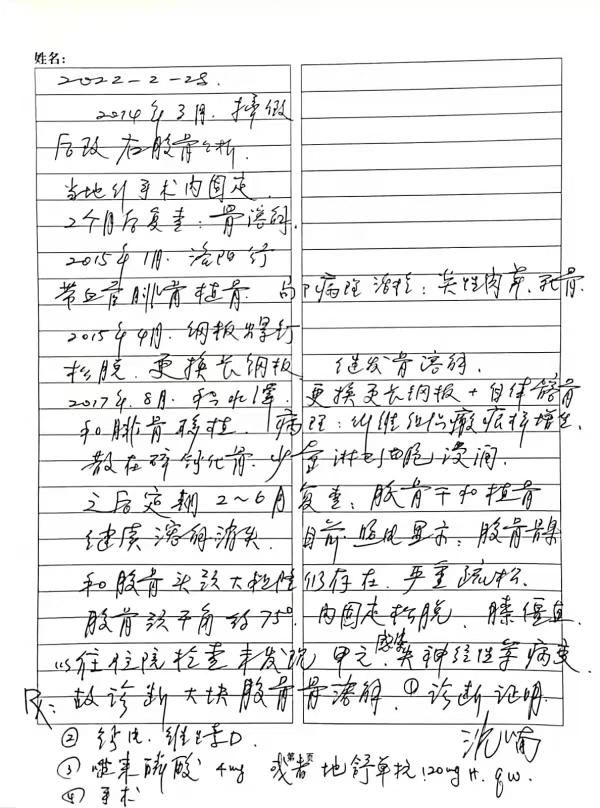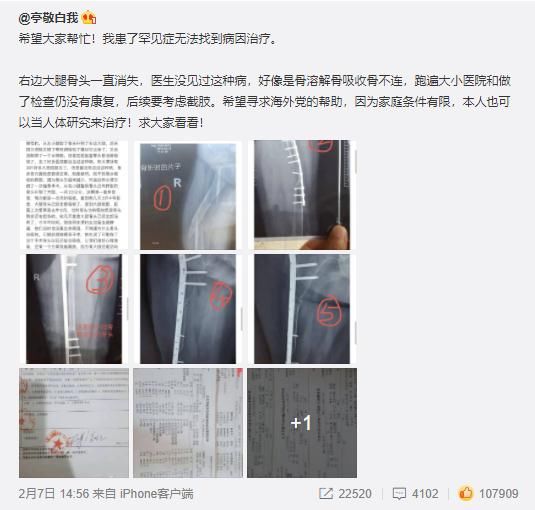“Eight years later, I finally waited for the diagnosis (result).” On February 28, Xiaoxue (pseudonym) published the disease diagnosis certificate issued by the hospital on Weibo. After diagnosis, she was diagnosed as idiopathic Osteolysis is a rare disease.

Koyuki was diagnosed with idiopathic osteolysis, a rare disease. Photo courtesy of the interviewee
In the past 8 years, the inexplicable “disappearance” of the right thigh bone has been tormenting Xiaoxue. In 2014, when she was in the third year of junior high school, she suffered a fracture of her right thigh due to an accidental injury. She underwent steel plate fixation surgery. During re-examination, she found that the wounded bones were shortening. Since then, she has sought medical treatment several times and underwent 2 bone grafting operations, but the bone in her right thigh continued to shorten, and the implanted bone up to 23 centimeters “disappeared”.

Xiaoxue sent help on Weibo.
Because the cause has not been found, a doctor suggested Xiaoxue amputation. On February 7 this year, Xiaoxue started asking for help through Weibo, hoping to get the help of experienced doctors. After the information for help spread on the online platform, Professor Shen Jingnan of the Department of Orthopaedic Oncology, First Affiliated Hospital of Sun Yat-sen University, got in touch with Xiaoxue. On February 25, Xiaoxue, accompanied by her father, went to the hospital for treatment and was diagnosed with idiopathic osteolysis.
On February 28, Ms. Chen, Xiaoxue’s mother, told The Paper that Xiaoxue will follow the doctor’s advice and receive weekly injections of denosumab and zoledronic acid to promote bone growth. . Follow up after a month, and then consider bone replacement.
Right now, the cost of medication and treatment still plagues the family. Ms. Chen said that Xiaoxue had received the first injection of denosumab in Guangzhou on the morning of the 28th and will return to her home in Handan, Hebei. However, she consulted in the past few days and found that the local hospitals in Handan may not be able to provide the two drugs, denosumab and zoledronic acid, and may have to go to the provincial capital Shijiazhuang or Beijing for injections in the future.

Xiaoxue underwent bone graft surgery in 2017, implanting a 23 cm piece of bone. Right: Re-examination in 2022 found that the bone was resorbed. Photo courtesy of the respondent
On the other hand, Xiaoxue’s treatment costs have already spent at least 500,000 yuan. Ms. Chen said that in order to take care of the children, she could not leave the house and sold alcohol to support her family. Xiaoxue needs 1,680 yuan for a single injection of denosumab, and will have to undergo surgery in the future. The cost of follow-up treatment is still a problem. They want to seek help from the Women’s Federation and other parties.
Public information shows that idiopathic osteolysis is also known as ghost bone, vanishing bone, vanishing bone syndrome and Gorham’s syndrome, massive osteolysis.
“Journal of Medical Imaging”, Vol. 20, No. 5, 2010, introduced that this is a rare disease. Osteolysis can occur in any bone, mostly single or multiple. The latter is easy to invade the joints and involve adjacent bones, and is usually ignored by patients in the early stage. By the time of X-ray examination, a large amount of bone has disappeared and often combined with pathological fractures.
Source: The Paper